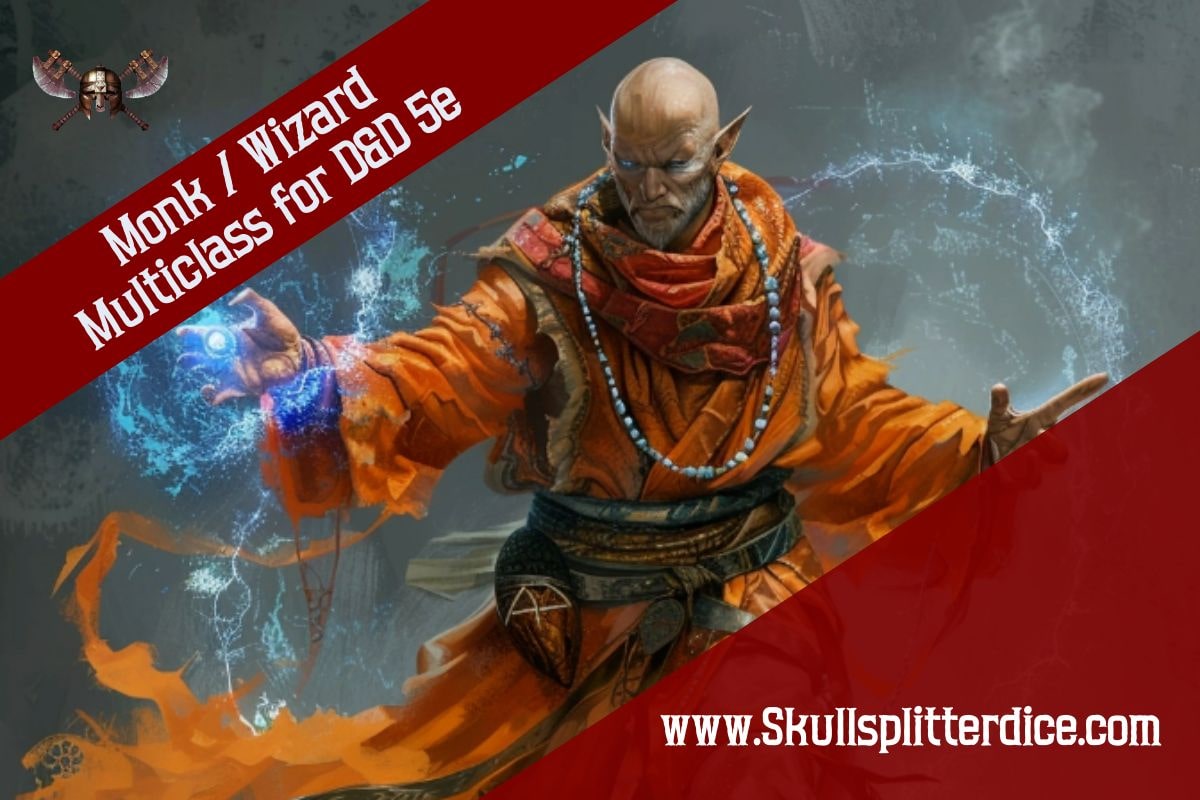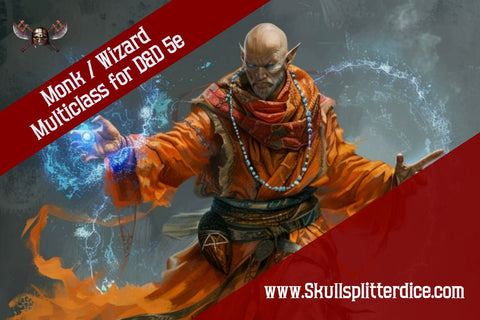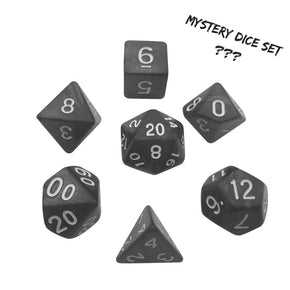
Monk Wizard Multiclass Builds for D&D 5e
Table of Contents:
Monk Wizard Multiclass Builds for D&D 5e
Speed, you are Speed
Monks are the pinnacles of discipline and martial technique that test the limits of humanoid capability. Wizards are the studious researchers of universal truths and the masters of arcane secrets. Put them together and you get a jumbled mess BUT with a bit of work we can turn that mess into a whirling ball of knives that moves faster than humanly possible. Grab your monk weapons and your spellbook as we go through everything you need to know.

Why Play a Monk / Wizard Multiclass?
Monk levels won’t add much to a wizard’s spellcasting, but a bit of wizardry can be a huge boost to running fast and punching people in the face. You run a Monk/Wizard build to run faster than WotC would have ever thought a player character could run. With a bit of effort we can maintain some good DPS while essentially becoming immune to melee attacks (unless our target can also run like the wind).
The ability split is a bit upsetting, but we can stack a few wizard and monk abilities together for a truly impressive AC, meaning that even when facing ranged opponents we’ll be nigh impossible to hit.
What are the Downsides?
The biggest issue with a wizard monk build is the ability score split. Monks already really need three scores, Dexterity, Constitution, and Wisdom. Wizards add Intelligence into the mix and there just won’t be enough points to spare to get all our scores as high as we’d like them.
There’re a few rules interactions that are a bit unintuitive in the way that spell attacks interact with monk features like martial arts. We can work through these and still make the class combination work, but you’ll need to be on top of using the character correctly to play without breaking rules technicalities.
Finally, as with every other multiclass character, we’re going to be reaching our mid-tier class options later and not reaching 20th level capstone features at all. This build isn’t too bad, but still expect to have a couple awkward early levels where the synergies haven’t really clicked yet and you lag behind your other party members in power level.
When Does a Monk / Wizard “Kick In”?
We have a couple variations, but each of our builds start with a core of 2 monk levels and 2 wizard levels. This means our monk wizard kicks in at the 4th character level with some additional goodies down the line.
What Class Features Do We Care About?
We’ve got the one core build here that depends heavily on several core class features. Let’s go through each of the special abilities that’ll factor into it and at least comment on the features that provide us with a bonus.
Significant Monk Features
- Unarmored Defense. Monks get an AC equal to 10 + Dexterity mod + Wisdom mod so long as they’re not wearing armor. Wizards are already known for not wearing armor so this is a pretty easy synergy so long as we can make sure we have a decent Dexterity and Wisdom.
- Martial Arts. This is the core defining monk ability that improves our unarmed strikes and allows us to make an unarmed strike as a bonus action. Remember that this is different from flurry of blows, and it’s basically the default “free” punch that we can make without spending ki or any other resource. The monk unarmed strike damage die is 1d4 instead of just a measly 1, and it improves with monk levels to 1d6, 1d8, and eventually 1d10.
- Ki. These are your mystical resources that you spend to fuel most of the monk’s abilities. Technically you gain a number of ki points as shown on the table, but it’s basically equal to your monk level starting at 2nd. And starting at 2nd, we get three abilities we can spend those monk points on. Flurry of Blows is the one we’ll be using most often, and it works exactly like our martial arts bonus action attack, but if we spend a ki point for flurry of blows, we make two extra unarmed strike attacks instead. Patient Defense lets us dodge as a bonus action at the cost of 1 ki point (which is situational but very useful). And finally Step of the Wind lets us dash or disengage as a bonus action for 1 ki, and also doubles our jumping distance for the turn. Step of the wind for a “free” dash is one of the ways we can get to ludicrous speeds.
- Unarmored Movement. Very simply monks get to move faster. When you first gain the feature with your 2nd monk level it’s 10 extra feet of movement and it improves to 15 feet at 6th level, 20 feet at 10th level, 25 feet at 14th level, and 30 feet at 18th level. Just the 10 extra feet is a huge boost to speed on its own, but you’ll see just how high we can stack it.
- Dedicated Weapon. In the optional rules monks got this new 2nd level feature that lets them turn any weapon into a “monk” weapon so long as it doesn’t have the heavy or special weapon properties. We won’t get any particular use out of this, but if we happen to find a particularly nice magic weapon that isn’t technically a monk weapon, we can still make use of it.
- Ki-Fueled Attack. Also gained from the optional rules, monks gain this ability at 3rd level to spend a ki point not on unarmed strikes but on another attack with a monk weapon. Usually, we’re going to be better off with a flurry of blows instead but there are some situations where one bigger thwack will be better than two little ones.
- Deflect Missiles. Starting at 3rd level we can use a reaction to reduce the damage taken by 1d10 + your monk level + your Dexterity modifier. You only have the one reaction but it’s incredibly handy to essentially negate the odd arrow that flies at you, especially since we plan on being essentially unreachable in melee.
- Quickened Healing. Gained at 4th level, you can spend 2 ki points to heal a number of hit points equal to a roll of your martial arts die + your proficiency bonus. It’s not a huge amount of healing for the cost, but you regain ki on a short rest and that healing can come in clutch.
- Focused Aim. This combat ability is gained at 5th level, you can increase your attack roll by +2 for every ki point you spend, up to a max of +6. This means every time you’re pretty sure you were close to hitting you can bump it up after the roll to push the hit through.
- Extra Attack. Just like most martial classes monks gain an extra attack at 5th level. This means we can make two attacks with our primary weapon and make a bonus action unarmed attack using martial arts, or with a ki point a flurry of blows gives us a total of 4 attacks, 2 with our primary weapon and 2 unarmed strikes.
- Stunning Strike. Also gained at 5th level, our stunning fist functions like a sort of "save or suck" spell at the cost of a ki point when we land a hit. If they fail the save, they'll be stunned until the end of our next turn. Stunned is a NASTY condition, and should usually spell doom for whatever you manage to hit with it.
- Monastic Tradition. Our core build doesn’t need the monk subclass at all, but it can be enhanced by one. We’ll go into the variations of the build we can accomplish using the different monk archetypes later mainly using their abilities at level 3.
- Evasion. Gained at 7th this lets us take half damage from failed Dex saves and no damage from passed Dex saves. A great feature that will make us more durable against breath weapons and the like, which are some of the most common damage sources that don’t use attacks.
Significant Wizard Features
- Spellcasting. We’re going for a martial build with a bit of arcane spice, so we’re not going to make use of most of the wizard’s massive spell list and we’ll instead be focusing on just a few spells at the early spell levels. Notably we’re going to be taking advantage of the frankly broken sword cantrips booming blade and green-flame blade, and we’re going to get even more speed using the spell longstrider.
- Arcane Recovery. A somewhat underplayed ability unique to wizards, once per short rest you can regain some expended spell slots. For us this will essentially just amount to an extra casting of longstrider.
- Arcane Traditions. Wizards pick up their archetype at 2nd level with most options providing a unique ability alongside a “specialization” in a specific spell school. For us, there is only one option and that’s bladesinger. Bladesinger lets us enter a “bladesong” using a bonus action, which lasts for 1 minute. While in this bladesong we get to add our Intelligence to our AC (which stacks with unarmored defense), we get yet another 10 feet of extra movement speed, advantage on acrobatics checks, and a bonus to concentration checks equal to our Intelligence modifier. You get a number of uses equal to your proficiency bonus.
Monk / Wizard Ability Scores
With this class combination we’re in a tough spot-on ability scores since we care about 4 of them. However, since we’re not planning on using our wizard spellcasting for actual damage, we really only need the minimum ability scores for wizard and can mostly play it off like a normal monk.
Our primary ability score should be Dexterity, since it factors not only into AC but also our attack rolls and it should be the main place for all our ability score improvements.
Our second highest score should be Wisdom, since it factors into our AC and while it doesn’t directly affect our attacks it will contribute to many of our important monk features.
After that we need to make sure we meet at least the minimum Intelligence score for multiclassing with wizard, which is 13. However, I recommend spending the point to push that up to 14 since that’ll increase our AC by 1 during our bladesongs.
Finally, any points we have left over should go into Constitution, since while we’re going to try hard not to be hit, it’ll still be nice to have a buffer.
I'd also recommend taking the variant human race will be ideal for the build. And by putting 1 point in both Wisdom and Dexterity, we can get the following starting ability scores using point buy:
Strength 8
Dexterity 16
Constitution 10
Wisdom 16
Intelligence 14
Charisma 8
If you don't go with variant human, normal humans also work quite well since +1 to each ability score applies to 4 scores we care about. Tabaxi are also a great option thanks to the natural weapons and the improved speed.
Monk / Wizard Equipment
The equipment is pretty simple for this build since we won’t be wearing a whole lot without any armor proficiencies. We’ll be relying on unarmored defense, so we won’t be wearing any armor or shields. If you maxed out Dexterity and sort of ignored Wisdom, you can also consider making use of mage armor, which may end up being a higher AC and still doesn't count as wearing armor for all our monk features. T
For weaponry, we need to stick to one-handed and specifically we want to use things that can count as “monk weapons” which is mostly simple weapons and a sparse selection of martial weapons. I recommend putting a short sword in each hand, and just keeping a spellcasting focus on your person rather than in your hand since most of our proper spellcasting will happen outside of combat.
Which Class Should I Start With?
The short answer is start with monk. We don’t gain any proficiencies at all when we multiclass into wizard, but with our starting ability scores we’ll be a fine monk, but an absolutely terrible wizard.
Monk / Wizard Feats
There are some other tempting feats but we have just one feat to make the build work and that’s mobile. Mobile is pretty simple, and provides us with the following bonuses:
- We get 10 additional feet of movement speed.
- Whenever we dash, we ignore difficult terrain.
- If we target somebody with a melee attack, they can’t make attacks of opportunity against us for the rest of our turn.
Every bit of this is amazing for our little speed demon. The 10 extra feet should be self-explanatory, giving us even more movement speed. Dashing is only something we’ll need to do if the enemy also has some serious speed, but this allows us to overcome what would be one of the build’s weaknesses in difficult terrain. Finally, the crown jewel that makes everything work is ignoring opportunity attacks. Unless the enemies are stacked up in such a way that you can’t single one out, we’ll always be able to avoid repercussions when we bolt in and out of combat.
Monk / Wizard Spells
We honestly won't be casting spells that much, but as with many arcane/martial builds we’re going to take advantage of the “sword cantrips”, namely booming blade and green-flame blade.
Booming Blade and Green-Flame Blade (Cantrips)
I’m lumping these two together because they’re functionally similar and we’re going to be abusing the heck out of both of them a LOT. Both of these cantrips use weapon attacks “as part of casting the spell”. This means we’re stacking the extra damage these cantrips do on top of whatever damage we do with our melee attack.
Note that this counts as “casting a spell” rather than taking the “attack action”. Which is unfortunate, because both martial arts and flurry of blows only trigger when we “take the attack action” and make an attack. However, there are going to be many turns where we need to use our bonus action for something else, like activating our bladesong or dashing to reach the target. On those occasions these cantrips allow us to essentially make up for the lost damage.
As for the actual effects of the spells, when you hit with green-flame you deal extra fire damage to another target adjacent to them. And when you hit with booming blade you force the target to stay still on their next turn or take 1d8 thunder damage if they move. Both spells improve drastically at 5th level, with green-flame in particular adding 1d8 fire damage to both the initial target of your attack and also to the extra adjacent target.
Longstrider
This is a very simple 1st level spell. On touch we can give ourselves 10 extra feet of movement. The spell lasts for 1 hour and doesn’t use concentration. For us, this is just a clean extra 10 feet and we’ll want it on essentially whenever there’s a chance combat will happen.
Core Monk / Wizard Multiclass Build
Alrighty let’s put the pieces together and get the core build up and running. We need 2 monk levels and 2 wizard levels selecting the bladesinger wizard archetype.
Our starting class needs to be variant human and select the mobile feat. If your DM doesn’t allow variant humans or you’ve got your heart set on something else, we can instead spend our 4th level ability score increase to pick up mobile.
In any dungeon delving situation or any other scenario you think might turn into combat, you’ll want the longstrider spell cast on yourself. Worst case scenario it’s only an action to cast so you can just start combat off with it. Finally, we just need a couple of regular old short swords in each hand.
So, how does this work? Well at the start of combat (or even right before if you’ve got the drop on them) we use a bonus action to start our bladesong, the final ingredient in our recipe for ultimate speed. We have 30 feet of base movement, + 10 feet of movement from the monk’s unarmored movement, + 10 feet of movement from the longstrider spell, + 10 feet of movement from the mobile feat, and + 10 feet of movement from our bladesong.
Without dashing or doing anything else, we’ve now accomplished 70 feet of base movement, which is quite frankly nuts. 70 feet is a sort of magic number, because it allows us to move 35 feet towards an enemy, and 35 feet away in the same turn. This means for most (at least humanoid) enemies, we can run up, attack them, and get to a distance they can’t get to in melee on their own turn. Thanks to the mobile feat, the target of our attacks also can’t make attacks of opportunity against us, and we can essentially make runs at them every turn until they die.
If 70 feet isn’t enough, as a monk we can dash as a bonus action just by spending a ki point, which means we can run a lightning fast 140 feet in a single turn while still using an action to attack!
As for actually dealing damage, on turns where just our movement can reach our target and get away from them, we can make our shortsword attack, and choose between making another one using our other shortsword, or spending a ki point for a flurry of blows (you don’t need a free hand to make an unarmed strike).
For situations where we need to use our bonus action (either for dashing or activating our bladesong) we can use our action to instead “cast” green-flame blade or booming blade through our sword attack, essentially making up for the lost attacks.
Finally, if they have range or somehow manage to catch up to you, your AC should be pretty healthy thanks to unarmored defense. With +3 in Wisdom and Constitution we’ll have a base AC of 16, but thanks to bladesong adding our Intelligence (hopefully +2) we get a lovely 18 AC. And as one final fallback, deflect missiles can catch the odd arrow that manages to find you.
Monk / Wizard Multiclass Builds
Now that we’ve established the core of the build, we can get into some variations paths you can take as you advance in levels.
Monk Ambulance
This one is very simple, by taking the way of mercy we take our speed demon and turn them into a one man health care delivery system. The way of mercy provides the ability to turn our ki points into healing (not a ton but enough to pop somebody back from 0) with a touch. Normally the big limitation here is proximity to your downed ally, but with a potential 140 feet of movement in a turn you’ll be able to provide medical assistance to a downed ally a city block away.
Speedy Drunk
We can get even faster using the power of booze. By taking the way of the drunken master we gain a few bonuses whenever we use our flurry of blows. When we flurry, we get to take the disengage action for free, which means that even when the enemy is grouped up we can still run away Scott free. Whenever we flurry, we also get 10 extra feet of movement! That stacks our base movement all the way up to 80 feet. Sadly, since flurrying uses our bonus action we won’t also be able to dash for a full 160 (at least while also making an attack), but the extra movement may well be worth a drink or two.
Supersonic Dragon
One last way we can take advantage of all this movement is by taking the way of the ascendant dragon. This will take a bit longer to kick in since the feature we really care about is at the 6th monk level, but hey, in the meantime we get to play around with some draconic breath weapons and alternate damage types.
The trick here is the 6th level feature wings unfurled, which lets us sprout spectral draconic wings whenever we use the step of the wind (the ki dashing feature). These magical dragon wings only last for the turn, but they grant us a flying speed equal to our walking speed, and our walking speed is fast. This supersonic dragon dash basically lets us do all our previously established speedy nonsense, but while flying, which means you’ll be able to threaten enemies over in the next area code.
https://www.skullsplitterdice.com/products/weekly-dice-subscription-sets
Want to grow your hoard? Check out our dice subscriptions!
Other Blog Posts You Might Like:
Our Complete Magic Item 5e Guide HERE.
Want to know how these dice work? Check out our DnD Dice Explained Guide!

Disclaimer
Last updated: January 27, 2019
The information contained on www.SkullSplitterDice.com website (the "Service") is for general information purposes only.
www.SkullSplitterDice.com is a participant in the Amazon Services LLC Associates Program, an affiliate advertising program designed to provide a means for sites to earn advertising fees by advertising and linking to Amazon.com. (source: Section 5)
Blueshift Nine, LLC assumes no responsibility for errors or omissions in the contents on the Service.
In no event shall Blueshift Nine, LLC be liable for any special, direct, indirect, consequential, or incidental damages or any damages whatsoever, whether in an action of contract, negligence or other tort, arising out of or in connection with the use of the Service or the contents of the Service. Blueshift Nine, LLC reserves the right to make additions, deletions, or modification to the contents on the Service at any time without prior notice.
Blueshift Nine, LLC does not warrant that the Service is free of viruses or other harmful components.
Affiliate disclaimer
This affiliate disclosure details the affiliate relationships of Blueshift Nine, LLC with other companies and products.
Some of the links are "affiliate links", a link with a special tracking code. This means if you click on an affiliate link and purchase the item, we will receive an affiliate commission.
The price of the item is the same whether it is an affiliate link or not. Regardless, we only recommend products or services we believe will add value to our readers.
By using the affiliate links, you are helping support the Service, and we genuinely appreciate your support.
Affiliate advertising programs that the Service uses are:
- Amazon Services LLC Associates Program
- As an Amazon Associate, I earn from qualifying purchases.
- Blueshift Nine, LLC is a participant in the Amazon Services LLC Associates Program, an affiliate advertising program designed to provide a means for sites to earn advertising fees by advertising and linking to Amazon.com or endless.com, MYHABIT.com, SmallParts.com, or AmazonWireless.com.
- Pages on this Service may include affiliate links to Amazon and its affiliate sites on which the owner of this Service, Blueshift Nine, LLC, will make a referral commission.


